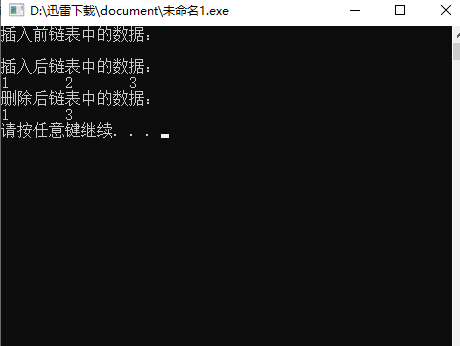序言
本文主要包括:
(1)单链表的创建
(2)创建结点
(3)打印结点
(4)链表的插入【头插法】
(5)链表的删除【指定位置删除】
适合新手初步认识学习单链表的基本操作
一、代码:
#include <stdio.h> #include <stdlib.h> #include<string.h> //结构体----结点由数据域+指针域构成 struct Node { int data;//数据域 struct Node* next;//指针域 }; //创建链表(表头) struct Node* createList(){ struct Node* headNode=(struct Node*)malloc(sizeof(struct Node)); //headNode 成为了结构体变量 //变量使用前必须初始化 //headNode->data=1;//一般不初始化数据 headNode->next=NULL; return headNode; } //创建结点 struct Node* createNode(int data){ struct Node* newNode=(struct Node*)malloc(sizeof(struct Node)); //初始化新结点 newNode->data=data; newNode->next=NULL; return newNode; } //打印结点(遍历结点) void printList(struct Node* headNode ) { struct Node* pMove=headNode->next;//打印指针指向头结点下一个结点 while(pMove) { printf("%d ",pMove->data); pMove=pMove->next; } printf(" "); } //链表的插入:插入结点---插入那个链表、插入结点的数据是多少 void insertNodeByHead(struct Node* headNode,int data){ //1、创建一个插入结点 struct Node* insertNode=createNode(data); //调用createNode方法创建一个新的结点 insertNode->next=headNode->next; headNode->next=insertNode; } //链表的删除:指定的位置删除 ---删除那个链表、删除的数据是多少 void deleteNodeByAppoin(struct Node* headNode,int posData) { struct Node* posNode=headNode->next; struct Node* posNodeFront=headNode; if(posNode==NULL) printf("链表为空!"); else{ while(posNode->data!=posData){ posNodeFront=posNode; posNode=posNodeFront->next; if(posNode==NULL){ printf("无法找到指定位置"); return; } } posNodeFront->next=posNode->next; free(posNode); } } int main() { struct Node* list=createList();//创建一个名为list的链表 printf("插入前链表中的数据: "); printList(list); printf("插入后链表中的数据: "); insertNodeByHead(list,3);//向链表list插入数据---3 insertNodeByHead(list,2);//向链表list插入数据---2 insertNodeByHead(list,1);//向链表list插入数据---1 printList(list); //打印链表 list printf("删除后链表中的数据: "); deleteNodeByAppoin(list,2);//删除链表中数据为2的 printList(list); system("pause"); return 0; }
二、运行结果:
